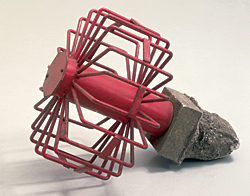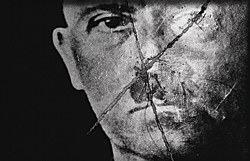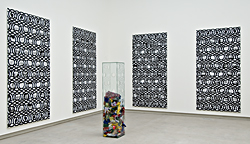Since the fall of the Berlin Wall in November 1989, Germany has reemerged as a potent intellectual and creative center within the international art world. In February 2007, the Mildred Lane Kemper Art Museum at Washington University in St. Louis will present Reality Bites: Making Avant-garde Art in Post-Wall Germany, the first thematic museum exhibition to examine how contemporary artists have dealt — both directly and indirectly — with the social, economic and political ramifications of German unification.

Reality Bites is conceived and organized by Sabine Eckmann, Ph.D., director and chief curator of the Kemper Art Museum. It is also the first major loan show in the museum’s new facilities, designed by Pritzker Prize-winning architect Fumihiko Maki, which were dedicated in October 2006. In all, Reality Bites will feature approximately 70 artworks created since 1989, by both German artists and international figures living in Germany. The vast majority of the artworks have never been exhibited in the United States. They range from video and photography to sculpture, installation, assemblage and new media art.
Artists consist of Franz Ackermann; Kutlug Ataman; Cosima von Bonin; Sophie Calle; Tacita Dean; Thomas Demand; Bernhard Garbert; Isa Genzken; Beate Gütschow; Rudolf Herz; Sabine Hornig; Christian Jankowski; André Korpys and Markus Löffler; Ulrike Kuschel; Eva Leitolf; Via Lewandowsky; Michel Majerus; Mariele Neudecker; Olaf Nicolai; Marcel Odenbach; Manfred Pernice; Daniel Pflumm; rude_architecture (Gesa Glück, Tobias Neumann and Friedrich von Borries); Silke Schatz; Gregor Schneider; Collier Schorr; Renata Stih and Frieder Schnock; and Wolfgang Tillmans.
One effect of German unification has been a new emphasis on experiential reality. In contrast to the abstract, simulated aspects of post-modernity, the historical realities of post-Wall Germany continue to influence the daily experience of its citizenry. Artists have reflected this in a number of ways: by employing pop-culture imagery and integrating the viewer into the creation of aesthetic experience; by creating visual spaces that compete with social environments; and by mimicking the rhetoric of globalization through the use of mapping and networking tools. Such strategies highlight the dissolution of established artistic forms — such as painting, sculpture and photography — while blurring the distinctions between art and everyday life.

Reality Bites, which Eckmann began organizing in 2003, consists of three thematic sections: “Re-dressing Germany,” “Traumatic Histories” and “Global Spaces.” Each explores a particular manifestation of change either initiated or accelerated by unification and its aftermath.
“Re-dressing Germany” examines a variety of new and often-conflicting national self-images in the areas of politics, economics and culture. Artworks by Majerus, Kuschel, Odenbach and Genzken challenge the official symbolism of post-Wall Berlin by embracing its physical reality. Odenbach’s video installation Niemand ist mehr dort, wo er hinwollte (No One Is Where They Intended to Go) (1989-90) recalls the moment of unification, while Jankowski’s video Haus des Ostens (House of the East) (2000) investigates nostalgia for the German Democratic Republic, and Ataman’s installation It’s a Vicious Circle (2002) explores the fragile nature of multiculturalism.
“Traumatic Histories” examines the painful legacy of events ranging from the Third Reich and the Holocaust to the oppressive East German regime and the terrorist Red Army Faction. Yet in contrast to earlier avant-garde movements, the artists in Reality Bites rely on neither expressionism nor the appropriation of Nazi aesthetics (as in the work of Anselm Keifer or Hans Jürgen Syberberg). Instead, they visualize narratives and create meaning through the use of fragmentary, mediated imagery. Works include staged and manipulated photographs by Demand, Schorr and Herz; Places of Remembrance (1993), an installation by Stih and Schnock; and a mixed media piece by Korpys and Löffler that investigates a 1970s apartment used by the Red Army Faction.

The final section, “Global Spaces,” focuses on the concept of “transnationalism,” an idea that gained prominence as post-Wall Germany responded to increasing globalization while attempting to address — or avoid — the fraught issue of national identity. Artworks in this section emphasize ways in which the technologies of globalization have reconfigured alleged boundaries between local and national, public and private, near and far. Hornig’s Large Cube in Forest (2004) examines the role of architecture in the age of globalization, while Majerus and Pflumm survey the impact of mass culture. Tillmans and rude_architecture propose the subway as a site for global encounters.
Reality Bites is made possible by an Emily Hall Tremaine Exhibition Award. Additional funding is provided by the Andy Warhol Foundation for the Visual Arts; Alston + Bird LLP; the National Endowment for the Arts; the Institut für Auslandsbeziehungen e.V.; the Missouri Arts Council, a state agency; the Regional Arts Commission; the Arts & Education Council; the Hortense Lewin Art Fund; Members of the Mildred Lane Kemper Art Museum; and individual contributors.
Reality Bites: Making Avant-garde Art in Post-Wall Germany will open with a reception from 7 to 10 p.m. Friday, Feb. 9, 2007, and will remain on view through April 29. The exhibition is free and open to the public. The Mildred Lane Kemper Art Museum is located at the intersection of Skinker and Forsyth boulevards. Regular hours are 11 a.m. to 6 p.m. Mondays, Wednesdays and Thursdays; 11 a.m. to 8 p.m. Fridays; and 11 a.m. to 6 p.m. Saturdays and Sundays. The museum is closed Tuesdays. For more information, call (314) 935-4523 or visit kemperartmuseum.wustl.edu.
Catalog and additional venues

In conjunction with the exhibition, the Kemper Art Museum will produce a full-color catalog featuring essays by Eckmann and Lutz Koepnick, professor of German and of film and media studies in Washington University’s College of Arts & Sciences. Other contributors include Diedrich Diederichsen, professor of theory at the Academy of Fine Arts in Vienna and at Merz Akademie in Stuttgart; Beate Kemfert, director and curator of the Opelvillen in Rüsselsheim, Germany; Gertrud Koch, professor of film studies at the Freie Universität in Berlin; and Iain Boyd Whyte, professor of architectural history at the University of Edinburgh. The 320-page catalog is published by Hatje Cantz and includes text in English and German as well as 210 color illustrations. Retail cost is $55. For more information, visit www.hatjecantz.de.
Following its debut in St. Louis, Reality Bites will travel to the Opelvillen, where it will be on view May 30 to Sept. 2. For more information, visit www.opelvillen.de.
Sabine Eckmann
Sabine Eckmann is director and chief curator at the Mildred Lane Kemper Art Museum at Washington University in St. Louis, where she also teaches in the Department of Art History & Archaeology in Arts & Sciences. She is the author of Collage und Assemblage als Neue Kunstgattungen Dadas (1995) and co-editor and co-curator of Exiles and Emigrés: The Flight of European Artists from Hitler (1997), which was named best exhibition catalog by the Association of International Critics of Art. She is editor of Exil und Moderne (2004), co-author of [Grid <> Matrix]: Screen Arts and New Media Aesthetics 1 (2006), and co-editor of Caught by Politics: Hitler Exiles and American Visual Culture (2007). Eckmann’s research interests focus on 20th- and 21st-century European art and visual culture, with a particular emphasis on the interrelation between aesthetic practices and social and political contexts. She has published and lectured on modern artists and their exilic practices, post-war German art, cold war aesthetics in German and American painting of the 1980s, participatory art forms of the 1990s, and new media and recent visualizations of trauma.
The Mildred Lane Kemper Art Museum

The Mildred Lane Kemper Art Museum dates back to 1881, making it the oldest art museum west of the Mississippi River. Throughout its history, the museum has focused on the work of contemporary artists and today boasts one of the finest university collections in the United States. Much of the outstanding modern collection was built by famed art historian H.W. Janson, author of the influential textbook History of Art (1962). In recent years the Kemper Art Museum has acquired a strong collection of photo-based and multimedia artworks, including major pieces by Eleanor Antin, Franz Ackermann, Christian Boltanski, Andrea Fraser, Isa Genzken, Candida Höfer, Christian Jankowski, Louise Lawler, Michel Majerus and Katharina Sieverding.
As part of Washington University’s Sam Fox School of Design & Visual Arts, the Kemper Art Museum is committed to furthering critical thinking and visual literacy through a vital program of exhibitions, publications and accompanying events, such as concerts, film screenings, symposia and lectures and discussions with distinguished visitors. In October 2006, the Sam Fox School dedicated two new buildings designed by Pritzker Prize-winning architect Fumihiko Maki. These included a new 65,000-square-foot, limestone-clad facility for the Kemper Art Museum, which more than tripled the museum’s previous exhibition space.
|
WHO: Mildred Lane Kemper Art Museum WHAT: Exhibition, Reality Bites: Making Avant-garde Art in Post-Wall Germany WHEN: Feb. 9 to April 29. Opening 7 to 10 p.m. Friday, Feb. 9. WHERE: Mildred Lane Kemper Art Museum, Washington University, near the intersection of Forsyth and Skinker boulevards. HOURS: 11 a.m. to 6 p.m. Monday, Wednesday and Thursdays; 11 a.m. to 8 p.m. Fridays; 11 a.m. to 6 p.m. Saturdays and Sundays. Closed Tuesdays. COST: Free and open to the public. INFORMATION: (314) 935-4523 or kemperartmuseum@wustl.edu |